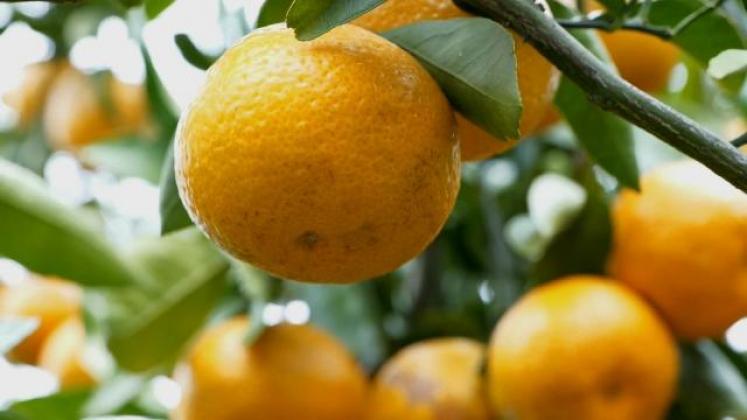
Heather Kirk-Ballard / LSU AgCenter horticulturist
It’s satsuma time in Louisiana. Some early varieties began ripening in late September while other varieties will continue to mature through late November on into early December. In the southern part of the state, satsuma harvest is well underway.
Satsumas are a great citrus variety to grow for home growers to have in Louisiana because they are one of the most cold-hardy citrus types we can grow in the South. And boy, are they delicious.
Officially known as the satsuma mandarin (Citrus unshiu), we have shortened the name to satsumas. The fruit is native to China and Japan, and they are grown in cool subtropical regions around the world. Satsumas are heavily cultivated in Japan, where most satsuma production is located in the southern part of the country. According to Peter Anderson at the University of Florida, the first record of satsumas in the United States was in Florida in 1876. The tree was named “satsuma” by the wife of General Van Valkenberg, a United States minister to Japan who sent the trees from Satsuma province on Kyushu Island, Japan.
In the early 1900s, a million Owari satsuma trees were imported from Japan and planted throughout the Gulf Coast states from northern Florida to Texas. It has become the major commercial citrus type grown in the South.
The fruit is easy to peel and has few seeds. The segments separate with ease, and the small size of the fruit makes it a highly portable snack for all. Even little kiddos can get through the soft and easily peeled rinds to get their hands on the juicy edible parts. Satsumas are high in vitamins A and C with a small amount of calcium and iron and one to two grams of fiber. The fruit is tart but sweet, slightly acidic and so delicious.
Satsumas are small to medium-sized evergreen trees with low-hanging, drooping branches. The branches commonly spread with an open growth habit, and the lower limbs should be pruned or supported to prevent fruit from touching the ground. Leaves are dark green and glossy, and the gorgeous white blossoms are some of the most fragrant when the blooms appear in early spring from March to April. The small, globe-shaped fruit are generally about 3 to 4 inches across. They turn from green in August to a bright orange in late September through early December, depending on the cultivar.
Roughly 100 cultivars vary slightly in their maturity dates, color, shape, size and quality. Some of the most popular cultivars for Louisiana are Owari, Armstrong, Brown’s Select, Kimbrough, Louisiana Early and Early St. Ann in order from earliest maturing to later maturing. Growing satsumas with different maturities allows homeowners and growers to harvest and eat the fruit for a long period.
Armstrong Early satsuma has large, fair-quality fruit reaching maturity in late September through October. Trees are dwarfed with upright growth habit.
Louisiana Early and Early St. Ann, two varieties released by the LSU AgCenter, produce medium to large fruit that mature in early September through mid-October. Overall, they offer better quality and productivity compared to the Armstrong Early. However, they can be difficult to find in retail nurseries.
Brown’s Select produces medium to large fruit that matures mid-October to early November. Trees are larger with open spreading branches.
Owari is the most widely grown satsuma and is a vigorous grower. The fruit is medium to small and seedless with excellent quality. It matures from early to mid-November but can be harvested through early December.
Kimbrough has large fruit that matures in early to mid-November. Trees are large with strong, spreading branches. They are very productive.
Satsuma trees grow best in well-drained, slightly acid to neutral, loamy soils with lots of organic matter and lots of sun. The more sun, the more flowers and fruit. Flowers have both male and female parts in the same flower and will pollinate themselves to produce fruit. And they smell great.
Plant citrus trees in winter during January and February.
Satsuma trees are typically grafted onto a hardier rootstock such as trifoliate (Poncirus trifoliate Rubidoux). They require fertilizer annually for good growth and yields of good size fruit. Do not fertilize newly planted trees. Wait until new growth is seen in spring to fertilize in March or April with a half-pound of balanced fertilizer such as 8-8-8 or 13-13-13 per tree. After the second year, fertilized in late January or early February with 1 to 1.5 pounds for each year of tree age up to 12 years old.
The main problem home gardeners will face with citrus is helping the trees survive hard freezes. Young trees are especially susceptible. Heavily mulch the root zone in winter, and consider protecting your trees during hard freezes by wrapping their trunks with blankets or burlap. You can also help by watering the ground underneath the trees a day or two before the cold because the moist soil helps radiate ground warmth.
Satsumas are worth any trouble, I think. I keep mine in a large pot on the patio with wheels for easily moving it during freezing conditions.
Keep in mind, there are insect pests and some devastating diseases in citrus including citrus greening and citrus canker. Citrus is currently quarantined in many portions of the state. Consult the Louisiana Department of Agriculture and Forestry at http://bit.ly/34ku4Md for quarantine maps. Another great resource for home growers is the Louisiana Home Citrus Production extension publication 1234 for more information. It’s available online at http://bit.ly/2JFx9ic.
